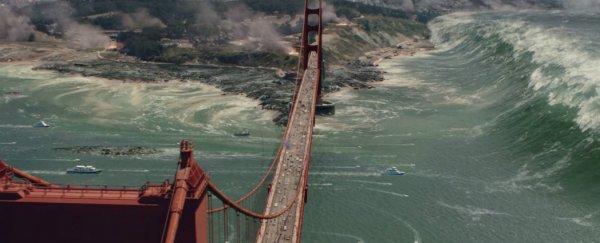San Andreas is currently packing out cinemas with a rather outlandish account of what could (but probably won't) happen in the event of a huge earthquake in California - but back in the real world, scientists say the tsunami threat to the west coast of the United States could be greater than was previously thought.
Geologists have pinpointed a number of major faults close to the southern California coast that are capable of producing magnitude 7.9 to 8.0 earthquakes. The newly explored faults highlighted by researchers are not quite on the scale of the San Andreas fault, but still have the potential to send tsunamis crashing into San Diego and Los Angeles.
"There is no need to panic and worry but you should be prepared now that we know there is a local tsunami potential," lead researcher and geologist Mark Legg, from consulting firm Legg Geophysical, told CBS News. "We know in the recent past, probably in the last few hundred years, there have been large magnitude 7-plus earthquakes on these offshore faults. So we should not be surprised if we have another one."
The last major quake generated by these particular faults was the magnitude 7 Lompoc earthquake. It hit in 1927 and created a 1.8-metre (6-foot) tsunami about 160 km west of Santa Barbara. Unfortunately, due to the high cost of mapping the ocean floor, scientists don't know as much about these faults as they would like to, and that makes predicting when the next earthquake will hit more difficult.
Geologists have known about these faults for some time, but what Legg and his team have done is study them in greater detail, and they've managed to spot evidence of upward and sideways movement. The researchers measured seafloor depth along a 4,500 km-stretch of the Santa Cruz-Catalina Ridge Fault and the Ferrelo Fault. Movement of the Earth's Pacific plate - sliding away from California - against the North American plate has caused these faults as well as the more well-known San Andreas one.
As the faults do not run straight through cities or populated areas, they tend to attract less attention, but Legg says a tsunami could still wreak havoc on cities, beaches and ports along the Californian coast. "We should not ignore the faults offshore," Legg says. "Yes, we should put our priorities on the faults onshore that go directly through cities and have the highest slip rates and most likely to produce large earthquakes … But the offshore faults are a major player in the movement of the Pacific plate along the North American coast."
The group's findings have just been published in the Journal of Geophysical Research. If you do catch San Andreas and the Rock in a movie theatre this week, remember that it's not quite as fictionalised as you might think.
